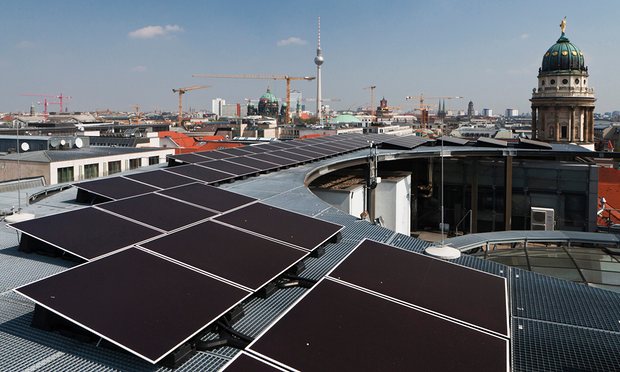[:pb]
Energy efficiency and renewables are indispensable weapons in the fight against climate change, but the real challenge is keeping fossil fuel reserves in the ground
At the UN climate conference in Paris in December 2015, 195 countries concluded a groundbreaking climate accord. They agreed to limit global warming to well below 2C to avoid extremely dangerous and irreversible climate change.
The international community’s remaining emission “budget” is less than 1,000 gigatonnes of CO2. The Paris agreement is intended to ensure as quickly as possible that the annual global emissions go down, the budget is stretched, and the net emissions of greenhouse gases are reduced to zero over a few decades.
The challenge of limiting the combustion of oil, coal and gas to this budget is enormous in view of the fossil reserves still underground. If we were to use all the known and probable reserves to generate energy, global emissions would amount to around 15,000 gigatonnes of CO2. So limiting global warming to 2C means this: of the 15,000 thousand gigatonnes of CO2, we need to leave at least 14,000 underground.
Truly, our problem is not a scarcity of fossil resources, it is the exact opposite. We lack an exit strategy for oil, coal and gas. Energy efficiency and renewable energy are indispensable parts of a response to climate change, but they do not tell us why private companies and private individuals should stop extracting, marketing and consuming fossil fuels.
In fact, the progress made on energy efficiency and renewables can actually exacerbate the problem. An oversupply of fossil resources lowers the price and makes it even more tempting to use them. And the temptation is great: the fossil energy industry offers profits, jobs and low energy prices.
The Paris agreement says this to our children and grandchildren: “We promise not to expose you to the dangers of climate change.” If we are to keep our word, we have no alternative to decarbonisation. Our production and consumption must become carbon-neutral. There is an international consensus that the industrialised countries need to lead the way.
Germany does not need to change its climate and energy transition targets in view of the decisions made in Paris. There is a consensus amongst the political parties represented in the Bundestag that Germany will reduce greenhouse gases by 80-95% by 2050 from the 1990 baseline. The Federal government and the Bundestag have decided on the following interim goals: greenhouse gas emissions are to be down 40% by 2020, 55% by 2030, and 70% by 2040.
We should regard this challenge as an opportunity for a comprehensive modernisation of our economy. The fossil fuels are being substituted by investment in efficiency technologies and renewable energy. Here, a key role will be played by digitisation. In short: we will replace oil, coal and gas with intelligence and sustainable investment by 2050 at the latest. By doing this, we will be creating high-quality growth and jobs. If this transformation is to become a success story not only in climate terms, but also in economic terms, in the coming decades, we will need a paradigm shift.
The most important aspect is to avoid misallocated investments. We want to complete the switch by 2050, which gives us three-and-a-half decades. Investments in fossil structures with a lifespan extending beyond 2050 will become stranded assets of the respective companies, and will require us to undertake expensive repairs in future. A forward-looking approach to modernisation which avoids lock-in effects, subsequent destruction of capital, and job losses, must put the right policies in place right now.
We should therefore declare efficiency and renewable energy to be the new “rule”, the new standard investment. Investments in fossil structures must become the exception. We should only undertake them in cases where we have no alternative technologies or where the alternatives are disproportionately expensive. We need to reverse the rule-exception relationship: that is the paradigm shift.
What does the new “rule” – investment in energy efficiency and renewables – mean for the various sectors?
Power generation still accounts for by far the largest proportion of greenhouse gases. The sector is also set to grow as the decarbonisation of the heating and transport sectors will only be possible if we use more electricity. This electricity needs to stem from zero-carbon renewable sources, particularly wind and photovoltaics. We need to keep investing in these technologies.
Fossil fuel power stations have a lifespan of 40 years or more. To avoid misallocated investment which reach far beyond 2050 and to avoid lock-in effects, we should urgently dispense with new coal-fired power plants and extensions to opencast mines. Gas-fired power stations with comparatively small carbon emissions fall into the “exceptions” category, because we need them as controllable power stations for our energy security; however, natural gas will have to be replaced gradually by zero-carbon.
Of all CO2-relevant emissions, buildings have the longest lifespans, at around 100 years. We should therefore define an efficiency standard for all new buildings which, when coupled with the direct use of renewable energy and electricity, results in zero carbon emissions. We already have the necessary technologies and they are already affordable, so that this new standard can be introduced with just a few years’ notice.
The challenges in the existing building stock are far greater. These buildings are dominated by gas-fired and oil-fired combustion systems which mostly heat buildings which are only moderately insulated. In the short term, a switch to using efficient condensing boilers can save a lot of CO2 emissions. As heating systems have a lifespan of 20 years, from 2030 investment in fossil fuel heating systems should stop so that we can finish the transition by 2050. The only cost-efficient way to do this is to combine it with appropriate insulation of the building envelope.
The transport sector may pose the greatest challenge. Most of the rail system has already been electrified, but almost all passenger and freight traffic on the road, in the air and on water is almost entirely dependent on fossil fuels. Electric mobility offers us the chance to achieve the energy transition in the field of private transport. With an average lifespan of 20 years we need to have switched from fossil-based to renewables-based engines by 2030 if we are to stop using gasoline and diesel on our roads in 2050. The emissions of newly bought vehicles must then amount to zero. We need a road map which enables the state and the automotive industry to draw up an ambitious investment strategy for the transport sector.
The paradigm shift in the energy transition cannot be applied to all sectors. The process-related industrial emissions, and the methane emissions from agriculture, cannot be avoided by higher efficiency or a switch to renewable energy. These emissions will continue unless we manage to develop alternative technologies. But by far the largest proportion of our emissions is produced by burning oil, coal and gas.
For this reason, a cost-efficient energy transition should be oriented to investment cycles with a view to a far-reaching decarbonisation by the middle of the century. Investments in efficiency and renewable energy must become the rule, and investment in fossil structures the exception with clearly defined timelines for an exit.
By adopting this forward-looking policy, we will avoid misallocations of investment and lock-in effects. It will enable Germany to follow a sustainable path of growth– whereas a continuation of investment in fossil fuels brings incalculable economic risks. In the aftermath of Paris, we are now seeing a race between nations to adopt the smartest and most cost-efficient modernisation policies. Thanks to its energy transition, Germany has a lead. We will have to work hard if we are to maintain this lead.
Fonte: The Guardian
[:]







